Late yesterday, Mohammed found something wrong with the minivan — alternator, or something — and so the tour company owner, Mr. Sharif, offered his services as chauffeur to go to Tanis. He’d never visited the delta city, so it would be an interesting outing.
It’s a long drive through the delta, even though as the crow flies it’s probably only about 75 miles, so we asked at the front desk of the hotel to pack us lunches. Tanis has no facilities, really, so we picked up the boxes for the four of us (Mr. Sharif, Fatteh, and us) and loaded them into the trunk of the car.
BTW, when you ask for a packed lunch, you should bear in mind that you could easily share one of these — they packed literally pounds of food for the four of us including roasted chicken, fruit, meat for sandwiches, rolls, sweets, and drinks.
Tanis
So, promptly at 8am, we met Fateh in the lobby and trundled out to the car — Mr. Sharif’s very large, very black mercedes. One of the big ones, a 5 series or something, tinted windows and all.
Remember that this is a big black mercedes. That will be very important later on.
Mark and I get in the back seat, and we head off through the city. There are two roads that head out to Tanis — the main highway, which skirts most of the city, and the agricultural road, which runs along one of the many canals and through the main industrial part of Cairo. The agricultural road passes through a ton of small towns, including Bubastis and Zagazig, and in general meanders around through the fields. Thinking the drive would be more interesting through the farm fields, we head off down the agricultural road.
The Agricultural Road
In the city, it snakes along the warehouses and loading docks and through the very edge of the Nile. We passed rail yards with old, narrow gauge tracks lined with flat cars. It was harvest season for sugar cane, so the trailer cars were piled high — higher than seemed possible — with long stalks of sugarcane. There were four or five posts on each car, with the canes laid between. When they reached the top, long stalks were laid crosswise and woven into the bundle to allow them to load another four or six feet of canes onto the cars. I wonder if they can fit through some of the narrow tunnels we’ve seen.
The factories that line the eastern edge of the city belch smoke into the already hazy air, and the faintly sweet-burnt-sugar smell of sugar cane processing overcomes even the thick, wet smell of the Nile and the harsh stench of burning garbage. Everyplace we go, the loading and unloading, harvesting and cutting are done by hand.
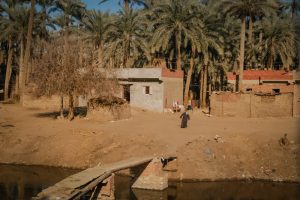
There are few houses in this part of Cairo, and what houses stand on the irrigation canals are small mud brick houses with thatched or palm-frond roofs. We get passed by trucks carrying enormous loads of sugar cane — or, more frighteningly, full loads of propane tanks. There are more of the truck-taxis here than we’ve seen anyplace else, carrying workers to the factories and to the farms laying further afield.
It doesn’t take long to leave the crowded warehouse district and suddenly we’re jouncing down a farm road between two lush, green fields. Roadside stands selling fresh carrots, cabbages, oranges, and mandarins start appearing. We stop at a stand and Fateh buys a 5 kilo bag of fresh mandarin oranges for about 3 pounds (less than a dollar) and we sit in the back seat peeling them and licking the juice off our fingers, spitting the seeds into a plastic bag on the seat between us. We’re careful not to get juice or sticky fingers on the leather interior of Mr. Sharif’s car, but I’m sure it will smell like citrus fruit for a few days. The bag didn’t last long.
I wonder, if we removed the power lines (where there are any) and the vehicles if rural Egypt is very different that it was 5000 years ago — mud brick huts with palm roofs and water wheels dot the landscape. it’s like driving in a time machine.
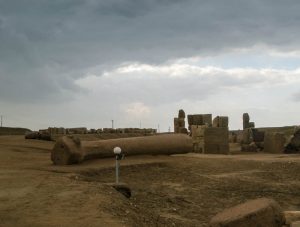
It’s blissfully cool outside, and we open the windows to enjoy the break in the weather. The clouds are gathering in the distance, ominously, but we’re driving along the roads between the fields and it’s cool and moist and the sun is shining. Mr. Sharif took a wrong turn on the way to Zagazig, and we had to backtrack down one of the dirt irrigation roads — about this time we figured that he was going to regret offering the use of his very nice car to drive around in towns with dirt and stone roads.
Zagazig, like every other town, was doing major road construction when we passed through, which necessitated driving the wrong way all the way through the narrow, one-way streets of the town to the other end, turning around over a narrow wooden bridge, and driving all the way back through the town to get to the main road. Zagazig is busy and crowded on market day, and the streets are crowded with sheep and goats and busses and little Vespa-taxis (3 wheeled jobs with a cart built over a tiny Vespa scooter). They al seem to have names: Romanni, Titnik, etc, and are outrageously decorated with paint, mirrors, bells, and tassels.
Tanis has a town associated with it, but it’s no where near the site of the ancient city, so once we reached the road to the necropolis, we were by ourselves again. The clouds were coming in dark, and by the time we saw the signs, it had gotten downright chilly. Well, chilly for the thin-blooded Egyptian’s — mark and I were thinking it was pretty comfortable. Then again, on the days when we’ve been wearing T-shirts and thin pants, Fateh has been showing up with a sweater and a jacket and bundling up even in the sun. I’m sure they’d be thinking we were overreacting if it was 104 degrees and we refused to step foot into the glaring sun, but it did get us a few raised eyebrows when we told them that we were fine, in fact, that we were quite comfortable. We explained that it had been 0 celsius at home, which was a bit shocking.
We’re in Trouble!
Pulling up to the gate leading to Tanis, we noticed a pickup truck loaded with the tourist police. As soon as we parked and got out, the driver of the pickup truck launched into an argument with Mr. Sharif and Fatteh. From the gestures and tone, it wasn’t a joyous welcome. In fact, we learned from Fatteh afterwards, the tourist police had waited for us at the appointed meeting spot on the road for almost half and hour, and then decided we had gone on without them and hauled a– to get to Tanis before we did, hoping to catch up to us on the way.
We had taken the “wrong road”. We had been unsupervised for nearly four hours. The police officer was not happy. We were supposed to take the highway and let them lead us to Tanis. We’d bucked the system and Fatteh and Mr. Sharif got a bit of a tongue-lashing over the whole thing. Mark and I (and Fatteh and Sharif) thought it was a bit over the top — we’d been fine, we just took the leisurely route.
As we were talking, another truckload of tourist police (a driver and four young men in the back with rifles) careened up the hill. Reinforcements, summoned by the first group of tourist police in case we really were lost or abducted.
Tanis Necropolis
Leaving the men to argue over the irresponsible behavior of our guide, Mark and I set off in search of a toilet. Three and some hours in the car and a bag full of mandarin oranges and I was wiling to settle for a bush beside the road. That might have been a good option, had I known that the teeny unlit bathroom we’d be shown was of the footplate-hole-in-the-floor variety. Actually, once you get the hang of it, the squat toilets aren’t too hard to manage, if a bit grimy. In fact, it was preferable to a few of the toilets we had used at the tourists sites — while they looked like regular flushing toilets, they were really temperamental and often leaked and the general level of sanitation was..questionable. But, a toilet is a toilet when you need one.
I really started to envy the directional plumbing of the men in the group when I contemplated the toilet. I don’t wear skirts often, which would have made the whole affair a lot easier, so I was stuck with trying to maneuver my khaki’s around my ankles, hold them out of the way (and off the floor!) and try to aim for a hole the diameter of a pop can. It’s honestly easier to take one leg out of your pants and bunch them to the side, but then you have to take off your shoe and try to replace it without stepping on the dirt-mud floor.
So far, so good. Of course, no toilet paper, just a hose with a little water to sort of rinse off, then drip try. Men have it so easy, I tell you!
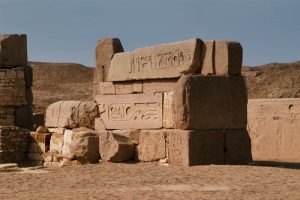
We emerged to discover that the group had apparently reached some sort of agreement, apologies and reassurances had been made, and we were free to examine the site. With the entourage of all the tourist police, of course, in case we tried to bolt. They had decided that since they had been lax in finding us before, we weren’t going to be let out of their sight. So, trailing a few young men with guns, we walked the enormous site with Fatteh explaining the history of Tanis and watching with some apprehension the gathering clouds.
And then it rained. Not much, mind you, a short drizzle, but it definitely rained. It didn’t faze us the slightest, but everyone else was tugging their collars up and buttoning their jackets. It lasted only a few minutes, but left behind that distinctive smell of rain and newly-wet dust. A few moments after that, the sun breached the clouds again and the tiny wet spots of raindrops disappeared almost instantly.
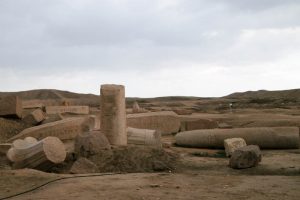
Tanis is an enormous open “museum” –– it was once the site of an enormous temple. Pieces of obelisks, chunks of walls, giant flat disks of columns are strewn on the site haphazardly, like a child’s blocks. Most of the stone is red granite, and quite a few of the pieces are artificially mounted on sandstone blocks, or stacked to create a hallway of mixed pieces. A few of the constructions are random, it seems– at least one wall is stacked blocks with no relationship to one another at all, half of them upside down!
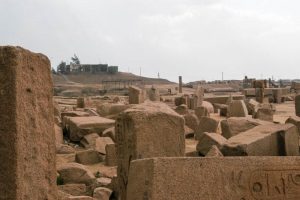
We couldn’t make out even a rudimentary outline of a temple here, although we could easily trace the mud brick walls that tower over the site, and a few of the cisterns — including a nilometer — are in place. There’s no water of course, but we realized just how far away from the Nile we were, and how close it must have been before the dam and in ancient times, to have filled these cisterns.
Obelisks lay all over the site, usually broken in pieces. From the remains, there would be ten or more here. One theory (which seems a little woo to me) is that they were “gongs” of some sort — that if you struck them with a hammer, they would resonate or hum. Columns and capitals are also strewn on the site — some are 6 feet in diameter, or more, perfectly round.
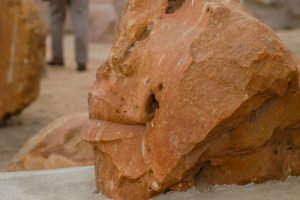
The remains of a colossus litter the ground in a number of places — a head here, a foot there, the oddly shaped piece of knee, a partial crown. The toe is over two feet long, the nail as big as my hand. It doesn’t look as if any work has been done here for many years. However, to the south on the site is a vast range of mastabas, and the latest excavation is believed to be the pharaoh Shoshenq V. The burial chamber is nearly freed of the sand, and the delicate reliefs inside are visible from the open roof. There are dozens of other mounds, obviously mastabas, but only Shoshenq’s is open to the air.
Temple of Mut
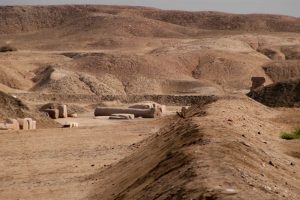
Far off to the right are the paltry remains of a temple to Mut, just a few stumps of columns sort of arranged in a square. Not much really remains, and we didn’t hike down the long road to examine them any more closely. We got some beautiful photographs as the sun came through the clouds again and lit the scattered statues.
Visiting Dignitaries
Since the tourist police decided that they had missed out on their chance to escort us to Tanis, they were definitely going to make up lost time by guiding us back to Cairo.
With enthusiasm.
So picture this: we’re in the back of a large, official-looking black mercedes car, with a truckload of armed tourist police ahead of us, another truckload behind, speeding through the farm roads to get back to Cairo. Every time we pass through an intersection, much honking and flashing from the lead tourist police car makes way for us to speed through…and then, just to complete the picture, we somehow attracted a local police officer on a motorcycle who STOPPED TRAFFIC in all the towns we passed through, with sirens and lights. We were whisked through town like visiting royalty…and all we could think was, “Well, if you wanted to avoid drawing attention to two lone tourists traveling in the Delta….yea, well, this would be the way to do it. Why don’t you just paint giant bulls eyes on our car?”
We were so embarrassed. No one was hostile, but you could tell that everyone was getting a bit annoyed. As far as we were concerned, we’d have rather just driven back with Sharif and Fatteh….but we weren’t given the option. We had a good laugh about it later, but spent the whole time squinched down in the seats hoping no one would notice us and think that this whole entourage was *our idea*.
Still, the ride back was about an hour shorter. Having someone stop traffic and shoo everyone out of the way definitely makes driving in Egypt easier.
Mr. Mohammed (our “regular” driver) thought that it was very funny when we recounted the story, and assured us that the tourist police had undoubtedly done it on purpose to convince Mr. Sharif to follow directions better the next time he drove!!
Stop the spinning!
George picked us up for the Dervish Show with Mr. Mohammed and the fixed van. It used to be in the House of Ghouria, but they are renovating the building (they are renovating just about everything) so the show is back at the Citadel. Odd music, very rhythmic and almost trance-inducing, but definitely not “western”. It took awhile to get it. After a few minutes, I was able to pick up the rhythm and even a melody, such as it was.
Dervishes are part of a Sunni sect that use this music and spinning around in place to induce a kind of religious trance and be more open to Allah’s words. They wear heavy felt “skirts” and turn in circles to achieve this.
The first guy spun in place for 35 minutes. THIRTY-FIVE. It made me dizzy just to watch. I’m glad that we waited to eat until after the show, or I’d have been seriously nauseous. We decided that an hour of music and spinning was enough, and left for dinner during a break in the show.
Dinner at a restaurant in the El Hussein street of the Khan el Khalili bazaar. The food was, as usual, amazing (Mark has Chicken Shawarma and I had Lamb Lebanese Style. Quite tasty. George had dinner with us, and we had a good time pumping him for information about tours and answering his questions about how we enjoyed Egypt. Too much food. Good food, but too much.